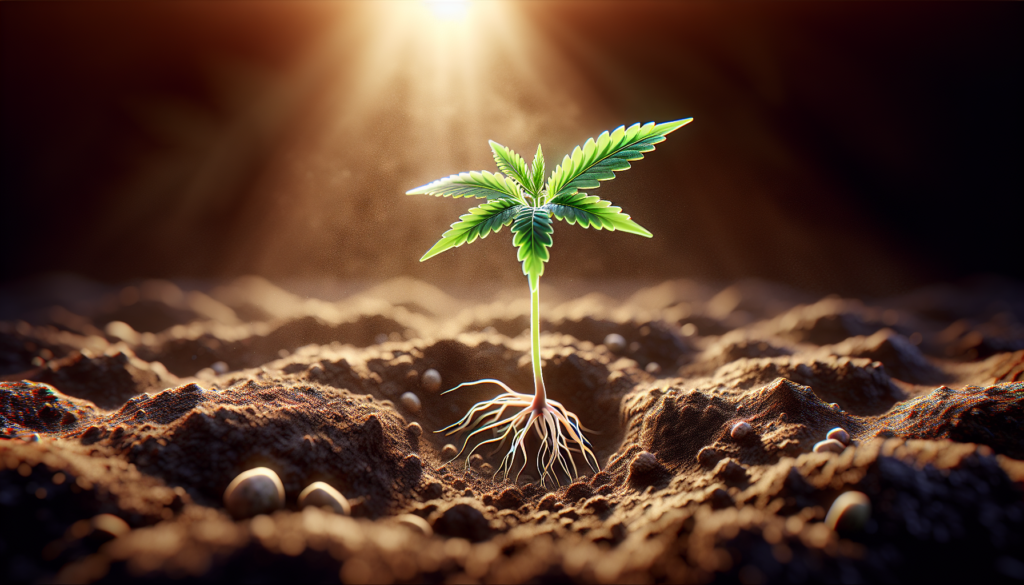How To Grow Cannabis From Seed

How To Grow Cannabis From Seed. You’re about to unlock the secrets of cultivating your own cannabis right from the very start – the seed. This journey isn’t just about tossing some seeds into soil and hoping for the best; it’s an art form that, when mastered, can yield a bountiful, high-quality crop. From selecting the right seeds to understanding the delicate process of germination, and navigating the growth stages all the way to harvest, you’ll learn each crucial step in creating your very own cannabis garden. Get ready to transform your thumb a vibrant shade of green; here’s your guide on how to grow cannabis from seed.
Understanding Cannabis Seeds
Before you get your hands dirty, let’s dig into the basics of cannabis seeds—the starting point of your cultivation journey. Cannabis seeds are the product of the pollination of female cannabis plants. When these seeds are planted and given the right conditions, they grow into new cannabis plants, each with its own unique characteristics.
Types of Cannabis Seeds
You’ll find several types of cannabis seeds available, each with distinct features. Regular seeds can grow into either male or female plants, so you’ll need to identify and separate the males to avoid seed production. Feminized seeds are bred to eliminate male chromosomes, which means they’re almost guaranteed to grow into bud-producing female plants. Autoflowering seeds, on the other hand, are bred to flower based on age, rather than changes in the light cycle.
Seed Genetics and Strains
When selecting seeds, you’ll encounter a dizzying array of genetic strains, each with its own flavor profile, growth characteristics, and effects. Strains can be pure (indica, sativa, or ruderalis), or hybrids, blending traits from multiple parent strains. Each strain has a specific set of conditions under which it thrives, so you’ll want to do your research and select a strain that suits your growing environment and personal preferences.
Feminized vs. Regular Seeds
Feminized seeds simplify the growing process by reducing the guesswork associated with sexing plants and eliminating the male plants. On the flip side, regular seeds may appeal to breeders or those who wish to experiment with plant genetics, as they produce both male and female plants.
Autoflowering Seeds Explained
Autoflowering seeds are ideal if you’re looking for a low-maintenance grow. These seeds are engineered to transition from the vegetative stage to the flowering stage without changes in the light schedule. They usually have a shorter overall growth cycle, making them a great choice if you’re after a quick turn-around or have space constraints.
Legal Considerations
Before you jump into growing, it’s essential to understand the legal landscape. Growing cannabis may be subject to different laws depending on where you live.
Know Your Local Cannabis Laws
Laws surrounding cultivation, possession, and use of cannabis vary widely. Some regions allow home cultivation for personal use, while others prohibit it altogether. Make sure to do thorough research to stay within the legal boundaries of your locality.
Legal Limitations on Cultivation
If home cultivation is legal in your area, there are often stipulations on plant counts, growing location, security measures, and more. You might only be allowed to grow a certain number of plants or need to keep your grow away from public view. Familiarize yourself with these restrictions to avoid any legal pitfalls.
Seed Acquisition and Compliance
Obtaining seeds legally is a crucial step in compliance. In regions where cannabis is legalized, seeds can be purchased from licensed dispensaries or online seed banks. Always keep receipts and any documentation in case you need to prove the legality of your seeds.

Preparing to Grow
Excitement’s in the air as you’re about to start your grow! Preparation is key to success, so let’s cover what you’ll need to create a thriving environment for your cannabis plants.
Gathering the Necessary Supplies
Your shopping list should include quality seeds, a growing medium (like soil or hydroponic materials), containers, lights, nutrients, a watering system, pH testing kits, and growth environment control tools such as fans and filters.
Choosing a Growing Medium
Selecting a growing medium will heavily dictate your gardening approach. Soil is the most traditional medium and can be very forgiving for newcomers. Hydroponics, where roots grow in a nutrient-rich solution, can be more complex but typically results in faster growth and larger yields.
Setting Up Your Growing Space
Whether you’re growing indoors or outdoors, your space must accommodate your plants as they grow. Indoors, you’ll need adequate lighting, ventilation, and space for your plants to reach their full potential. Outdoors requires a secure, sunny spot with good soil and access to water.
Understanding Nutrient Requirements
Cannabis plants require specific nutrients at various stages of their lives. Generally, they need more nitrogen during vegetative growth and more phosphorus and potassium during flowering. A balanced nutrient solution specially formulated for cannabis can ensure they get everything they need.
Germination Process
The first step in the life cycle of your cannabis plant is germination, where your seeds sprout and begin to grow.
Methods for Seed Germination
There are a few methods for germination, including planting directly into the soil, using starter plugs, or the popular ‘paper towel method’ where seeds are placed between moist paper towels until they sprout.
Optimal Conditions for Germination
Seeds need moisture, warmth, and darkness to germinate. Maintain a consistent temperature (around 70°F or 21°C) and ensure that the seeds never dry out. With the right conditions, seeds typically germinate within a few days to a week.
Transplanting Germinated Seeds
Once your seeds have sprouted and the seedling shows its first set of leaves, it’s ready to be carefully transplanted into your chosen growing medium. Handle the delicate sprouts with care to avoid damaging the taproot.

Seedling Care
Your little green sprouts are now seedlings and require close attention to flourish.
Optimal Environment for Seedlings
Seedlings thrive in a humid environment with temperatures slightly warmer than during germination. They’ll need less intense light than mature plants, so set up your lights appropriately or use a shaded area if you’re growing outside.
Watering and Feeding Your Seedlings
Overwatering is a common mistake. Water seedlings when the top of the soil is dry to the touch. At this stage, they require minimal nutrients, so be cautious with fertilization; you can usually wait a few weeks before introducing half-strength nutrients.
Monitoring Seedling Growth and Health
Keep an eye out for signs of distress, like discoloration or drooping. These could indicate issues with water, nutrients, or disease. Act promptly to address any issues to keep your seedlings robust and healthy.
Vegetative Stage
As your plants grow, you’ll enter the vegetative stage, where they focus on getting big and strong.
Lighting Requirements and Schedules
If you’re growing indoors, you’ll need to mimic the sun’s light cycle. Typically, cannabis plants in the vegetative stage will require 18 hours of light and 6 hours of darkness. Outdoors, they’ll naturally thrive in the long sunny days of summer.
Pruning and Training Plants
Pruning and training help your plants grow efficiently and yield more. Techniques like topping and low-stress training (LST) can increase light penetration and air flow to lower parts of the plant, resulting in an even canopy and bigger buds.
Pest and Disease Management
Stay vigilant against pests and diseases. Regularly check your plants for signs of trouble and employ pest control and plant hygiene practices. Organic pesticides and healthy growing conditions can prevent most issues before they become serious.
Flowering Stage
You’ve made it to the flowering stage, where your plants will start to produce the coveted buds.
Triggering the Flowering Phase
To initiate flowering, indoor plants require a change to a 12/12 light cycle, mimicking the shorter days of autumn. Outdoors, plants will naturally enter this phase as the seasons change.
Adjusting Nutrients and Watering Practices
During flowering, you’ll adjust the nutrient mix to one higher in phosphorus and potassium to support bud growth. Watering may also need to be more frequent as your plants’ size and metabolism increase.
Monitoring Buds for Maturity
Watch your buds as they swell and mature. Trichomes, the tiny crystal-like structures on the buds, will turn from clear to milky white to amber. This color change is a key indicator of when to harvest for the desired effects.
Harvesting Cannabis
Harvesting is the most rewarding part of growing cannabis. It’s when you finally get to collect the fruits of your labor.
Determining the Right Time to Harvest
Timing is critical. Harvest too early, and you might miss out on potency and yields. Too late, and the effects of your cannabis may change. Use the color of the trichomes as your guide, and remember, patience pays off.
Harvesting Techniques
When it’s time to harvest, you can choose to snip individual buds or chop down whole branches. Be gentle and careful to not shake off the precious trichomes that contain the cannabinoids and terpenes.
Drying and Curing Cannabis Buds
After harvesting, you’ll need to dry your buds in a controlled environment to prevent mold and prepare them for smoking. Curing in glass jars for several weeks will improve the flavor and efficacy of your cannabis.
Common Problems and Solutions
You may face challenges along the way, but most can be overcome with a little know-how.
Addressing Nutrient Deficiencies
Yellowing leaves or stunted growth can indicate a nutrient deficiency. A proper feeding schedule and balanced nutrients usually prevent and resolve these issues.
Managing Pests and Diseases
Healthy plants can resist pests and diseases, but if you encounter them, identify the problem quickly and use organic pesticides and fungicides as needed. Keeping your grow room clean can prevent many problems altogether.
Troubleshooting Growing Issues
From nutrient burn to hermaphrodite plants, a host of issues might arise. Stay calm, investigate symptoms, make necessary adjustments, and consult more experienced growers or reputable sources for advice.
Sustainability in Cannabis Cultivation
Sustainable practices in cannabis cultivation are not just good for the environment, they can also lead to healthier plants and better quality buds.
Organic Growing Practices
Opt for organic fertilizers and pesticides, and use natural methods for pest control. Not only will you be avoiding harmful chemicals, but you may also find that going organic enhances the flavor and quality of your cannabis.
Reducing Water and Energy Usage
Be conscious of your water and energy use. Collect rainwater for irrigation and consider energy-efficient LED grow lights, which can significantly reduce your electricity consumption.
Composting and Recycling Grow Media
Finally, consider composting your plant waste and recycling your grow media if possible. This will not only reduce your environmental footprint but also maintain a closed nutrient cycle in your growing system, improving soil health and fertility.
Conclusion How To Grow Cannabis From Seed
Growing cannabis from seed can be an incredibly gratifying experience. By following these guidelines and remaining attentive to your plants’ needs, you’ll be well on your way to a successful harvest and the satisfaction that comes with growing your own. Happy planting!



